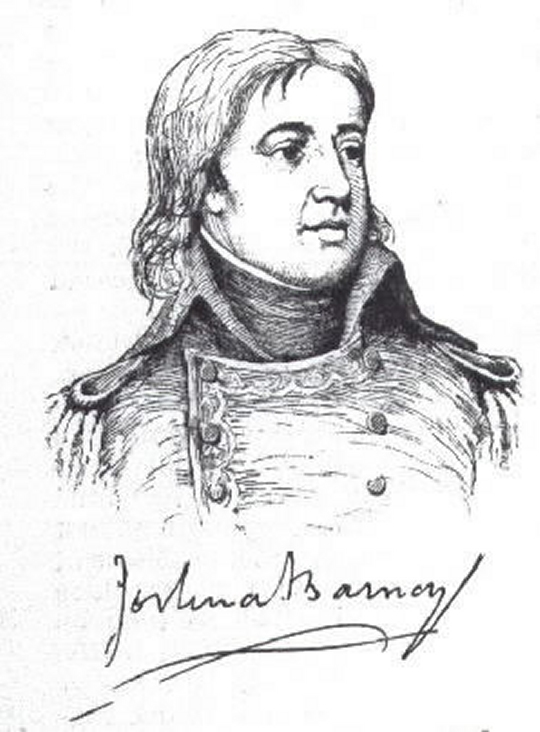 Sketch of Joshua Barney circa 1800. Barney (6 July 1759 – 1 December 1818) was an American Navy officer who served in the Continental Navy during the Revolutionary War. He later achieved the rank of commodore in the United States Navy and also served in the War of 1812. He was born in Baltimore. —Wikipedia
Sketch of Joshua Barney circa 1800. Barney (6 July 1759 – 1 December 1818) was an American Navy officer who served in the Continental Navy during the Revolutionary War. He later achieved the rank of commodore in the United States Navy and also served in the War of 1812. He was born in Baltimore. —WikipediaPATUXENT RIVER, Md. (July 22, 2016)—Archaeologists from Naval History and Heritage Command (NHHC) Underwater Archaeology Branch (UAB) surveyed several sites on the Patuxent River in Maryland over the past 1-1/2 weeks in search of ships from Commodore Joshua Barney's scuttled flotilla, concluding field work July 20.
During the War of 1812, Barney organized a plan to defend Chesapeake Bay from British raids along its banks. After assembling about 16 vessels comprised of armed barges and gunboats, he met the Royal Navy on the Patuxent. The flotilla was successful in diverting the British for several weeks, but ultimately Barney was ordered by Secretary of the Navy William Jones to scuttle the ships to prevent them from falling into the hands of the British.
Fast forward 202 years. The area has flooded several times, the river channel may have migrated, the banks have eroded, and two centuries of sediment have built up on the river bottom. The historic flotilla rests in a complex riverine system of wide marshes to narrow multi-channel river inlets. Analysis of existing maps and charts indicates the strong likelihood of continued change. Much like the Navy and society itself, the river of today is not the river of yesterday. Up to now, only one ship is believed to have been found—the sloop Scorpion.
UAB hopes to change that with continued field work, but given the conditions, they understand they can't be sure of what they'll find.
"Archaeological research is a laborious multi-phase process," said George Schwarz, an underwater archaeologist with NHHC's UAB. "Archival research exploring the history of the site, past investigations, environmental information, and logistical planning ultimately led to the field research phase."
The search for the rest of the scuttled flotilla is a continuation of research conducted by NHHC and partners, including the state of Maryland, initiated in 2009 with Scorpion.
With support this year from Maryland's Patuxent River Park and Naval Historical Foundation, this third field season saw UAB investigating targets detected during the previous two summers' remote-sensing work in attempts to find the remainder of the flotilla.
In 2014 and 2015, UAB used marine magnetometer, side-scan sonar, sub-bottom profiler, and sediment cores to examine areas of interest. Using a hydro-probe, which simply provides a steady flow of water through a pipe to loosen sediment layers, they probed around magnetic anomalies in a gridded pattern this summer.
"[With the hydro-probe], depending on the density of the material the probe runs against, we are often able to tell whether there may be buried wood or metal at the location," said Schwarz. "When we systematically collect data points and plot them on a grid, we can start to determine if a pattern emerges of what is buried below the surface; if we're lucky, we might get the outline of a hull."
However, it will take the UAB some time to thoroughly analyze and interpret the data they collected. If the data indicated the presence of manmade materials, they'll need to determine if they have found something insignificant, like old industry materials, or if they have found parts of a ship. That determination will influence whether it is appropriate and necessary to further excavate the site.
For more on the toughness of the Chesapeake flotilla's Sailors, read how, after abandoning their ships, they defended Washington, D.C. as the British closed in on the capitol ( usnhistory.navylive.dodlive.mil/peoplematter-as-others-ran-sailors-and-marines-make-a-stand-at-bladensburg/ ). They also saw further action as Baltimore's Fort McHenry was bombarded by the British ( usnhistory.navylive.dodlive.mil/through-rockets-red-glare-flotilla-sailors-stand-strong/ ).
The Naval History and Heritage Command, located at the Washington Navy Yard, is responsible for the preservation, analysis, and dissemination of U.S. naval history and heritage. It provides the knowledge foundation for the Navy by maintaining historically relevant resources and products which reflect the Navy's unique and enduring contributions through our nation's history, and supports the fleet by assisting with and delivering professional research, analysis, and interpretive services. NHHC is composed of many activities including the Navy Department Library, the Navy Operational Archives, the Navy art and artifact collections, underwater archeology, Navy histories, nine museums, USS Constitution repair facility and the historic ship Nautilus.
For more news from Naval History and Heritage Command, visit www.navy.mil/local/navhist/.


